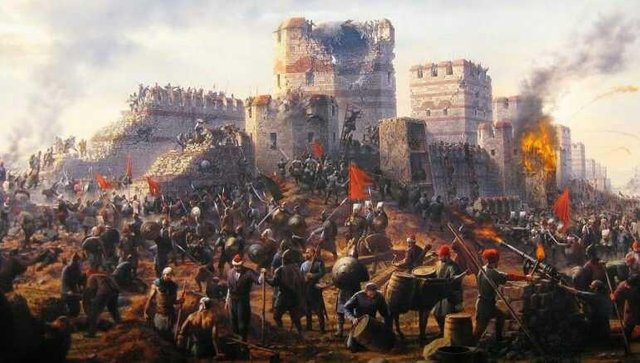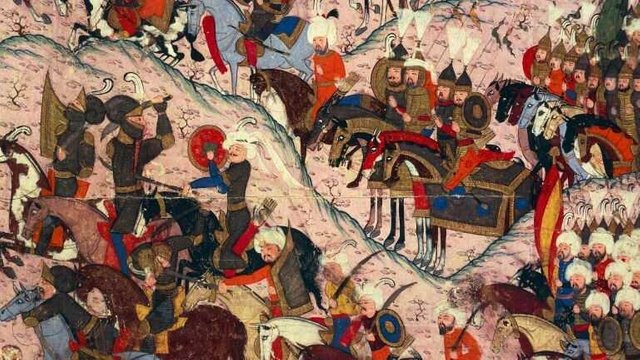The Fall of Constantinople and the Birth of İstanbul
The year was 1453. The exact date 29th of May. As the spring was to hand over the rule to the summer, so was Constantine XI, the Byzantine Emperor to hand over his rule to the young Mehmed II, the Ottoman Sultan who was just 21 years old at the time. Constantinople fell and it became Stambol, or as it was later to be named - İstanbul. This was not just an ordinary event, it changed the course of history on many levels. The Byzantine Empire (also known as Eastern Roman Empire) was the only successor of the Roman Empire, which fell in 476. Being the successor of the Roman Empire means being the protector of Christianity and its ideas. The Ottoman Turks brought İslam with themselves, to which they were introduced a few centuries before. We can thus say that a place of such an geographical and historical importance as Constantinople/İstanbul forever changed. The fall of Constantinople
The fall of Constantinople
The Ottoman Turks
In this chapter I would like to describe the way of living which the Ottoman Turks followed, after which we will be able to understand why they decided to conquer Constantinople.
The Turkic peoples originally came from what is today Mongolia and parts of China. The first non-turkic records of the name Türk were found in the Chinese documents regarding relations with their neighbors. First writings in the Old Turkic were the Orkhon Runes, a script chiselled into the stone columns found in the valley of the Orkhon river in Mongolia. The Turkic people (not just the Turks) established few Khanates (more precisely 3), and after the last one fell apart they started to migrate westwards. The main trigger which induced their moving westwards was, besides them being nomadic people, the Mongolian conquest which affected the entire Asia and a large part of Europe. Turks were some of the tribes and ethnicities moved by the conquest. Some of them even joined the Golden Horde. Meanwhile many now separate Turkic tribes started to form their own ethnic groups, even states. One of them was the Oğuz branch of the Turkic people, from which later, along with Turkmens and the Azeri Turks, originated the Ottoman Turks. They were all introduced to the Islamic faith and were due to the geographical vicinity brought to contact with the Persians, and thus the Arabs. They later arrived to the Eastern Anatolia which was at time border area of the Byzantine Empire. İn 12th and 13th century the Byzantine Empire was on the verge of falling apart and was already made to employ various ethnic groups on the eastern border to guard it (an indicator of a state falling apart). The Ottoman Turks chose Osman as their first leader, after who came a series of successful sultans lasting up to Süleyman the Magnificent. Probably the most successful of the sultans (besides Süleyman) was Mehmed II, who also became known as Fatih (The Conquerer) after conquering the Constantinople. Before İstanbul the Ottomans already established their rule in Bursa (the first capital of Ottoman "Empire"), but in 1453. they were also granted an easier access to Europe (their eyes were somewhat always looking towards Vienna). They could now easily rule from a big city on two continents which enabled them to govern both Anatolia and the Balkans. The fall of Constantinople was the event which in the led to the introduction of the Ottoman Empire to Europe. It is actually well known that the Ottomans weren't bloodthirsty, savage barbarians as presented in the western literature. İstanbul became a multicultural metropolis comprising not only Turks, but also Armenians, Jews, Greeks, Slavs and many other nations with many different languages and religions. Even though the Islam was the official and dominant religion in the empire, Christianity and Judaism were also accepted, and both Christians and Jews were allowed to exercise their religion, of course by committing themselves to pay the tax called "cizye". Prosecution of other religions was strictly forbidden (compare the Crusades and their actual achivements!) . And such is the story of İstanbul, as well.
Written by: @tinmar
HTML design: @sulepower
@steemagazin team: @atimk23, @tinmar, @kalu24, @sulepower, @strictlybusiness, @kekec
This is @steemagazin original content. All rights reserved.
Links: Pictures https://www.realmofhistory.com/2016/12/29/animation-fall-of-constantinople-1453-ad/
https://www.history.com/.amp/topics/middle-east/ottoman-empire
Congratulations @steemagazin! You have completed the following achievement on the Steem blockchain and have been rewarded with new badge(s) :
Click on the badge to view your Board of Honor.
If you no longer want to receive notifications, reply to this comment with the word
STOPDo not miss the last post from @steemitboard:
Downvoting a post can decrease pending rewards and make it less visible. Common reasons:
Submit
Thanks for using eSteem!
Your post has been voted as a part of eSteem encouragement program. Keep up the good work! Install Android, iOS Mobile app or Windows, Mac, Linux Surfer app, if you haven't already!
Learn more: https://esteem.app
Join our discord: https://discord.gg/8eHupPq
Downvoting a post can decrease pending rewards and make it less visible. Common reasons:
Submit